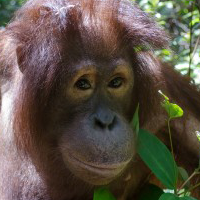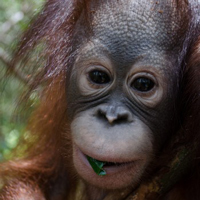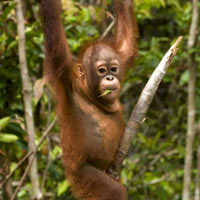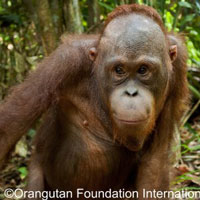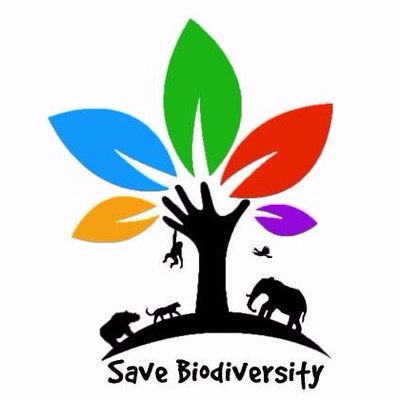Brave Little Ben: Orangutan of the month
When I arrived at the Care Center more than six months ago, Ben was the smallest infant in OFI’s care. He always seemed a little timid, and when he was taken into the forest, he was often too afraid to explore the trees. Instead, he liked to cuddle up in a caregiver’s lap where he… Continue reading Brave Little Ben: Orangutan of the month
Caroline, a True Beauty of an Orangutan
Out of the 300+ orangutans who reside at OFI’s Orangutan Care Center and Quarantine (OCCQ) in Kalimantan Tengah (Central Indonesian Borneo), Caroline doesn’t stand out in the crowd. She’s small for her age, rather sparsely haired, and – to put it bluntly – a bit scrawny. But what she lacks in physical beauty and brawn,… Continue reading Caroline, a True Beauty of an Orangutan
The Story of Sun Bears Bernie and Wawang
A year and a half ago, on August 1, 2012, thanks to the encouragement and support of Dr Biruté Mary Galdikas and Orangutan Foundation International (OFI), I was given the opportunity to begin the rehabilitation of two captive orphan sun bear cubs back to the wild. The youngest, Bernie, a female, was about 6 months… Continue reading The Story of Sun Bears Bernie and Wawang
Orangutan of the month: Vanessa
The Orangutan Care Center and Quarantine(OCCQ) is surrounded by several camps that consist of sleeping enclosures for the orangutans and basic facilities for staff. Pondok Medang is one of these camps, located within OFI’s rehabilitation forest and currently home to 25 adolescent orangutans who are preparing for permanent release into the wild. When you visit… Continue reading Orangutan of the month: Vanessa
Orangutan of the Month: Cory Marder
If grades were assigned in forest kindergarten, little Cory would certainly be top of her class. She is smart and also very driven, practicing and honing her forest survival skills every moment she is out in the Care Center’s rehabilitation forest. But Cory Marder is not only smart, she is also very pretty with her… Continue reading Orangutan of the Month: Cory Marder
Charming Cabang: Orangutan of the Month
Most of the orangutans at the Orangutan Care Center & Quarantine (OCCQ) in Pasir Panjang, Kalimantan Tengah, Indonesia, have come into OFI’s care as a result of habitat destruction. Rainforest conversion to palm oil plantations, logging, and mining leads to fragmentation of the orangutan’s habitat, leaving orangutans with little choice but to enter plantations in… Continue reading Charming Cabang: Orangutan of the Month
Tommy: a little orphan with a big heart
Doing conservation work can be exciting but also challenging and sometimes disheartening due to the hard odds arrayed against protecting habitat and animals in the wild. As a volunteer and fundraiser for OFI, I am inspired by and find a source of strength from the many young orphan orangutans I work with at OFI’s Orangutan… Continue reading Tommy: a little orphan with a big heart
Orangutan of the Month: “Dewa”
Dewa is a now a nine year old male orangutan who stole my heart on my very first day of volunteering in 2012 at OFI’s Orangutan Care Centre and Quarantine in Pasir Panjang, Kalimantan Tengah, Indonesia. In just one week Dewa and I became special friends. It has been such a delight getting to spend… Continue reading Orangutan of the Month: “Dewa”
Orangutan of the Month: Daring Dominique
When I am with the infant and juvenile male orangutans at the Orangutan Care Center and Quarantine (OCCQ), I sometimes picture what they will look like when they are fully grown. In their first years of life, all orangutans develop slowly and maintain a fairly small size. But once they enter adolescence, male orangutans in… Continue reading Orangutan of the Month: Daring Dominique
Cute Faces, Dark Realities (Part 1)
Look at these photos of infant orangutans. What are the first thoughts that come into your head? My guess is that your reaction is something like, “So cute!” or “I want to cuddle them!” Maybe you’re even thinking, “I want one!” Unfortunately, the charms that orangutans and other primates possess push too many people to… Continue reading Cute Faces, Dark Realities (Part 1)



